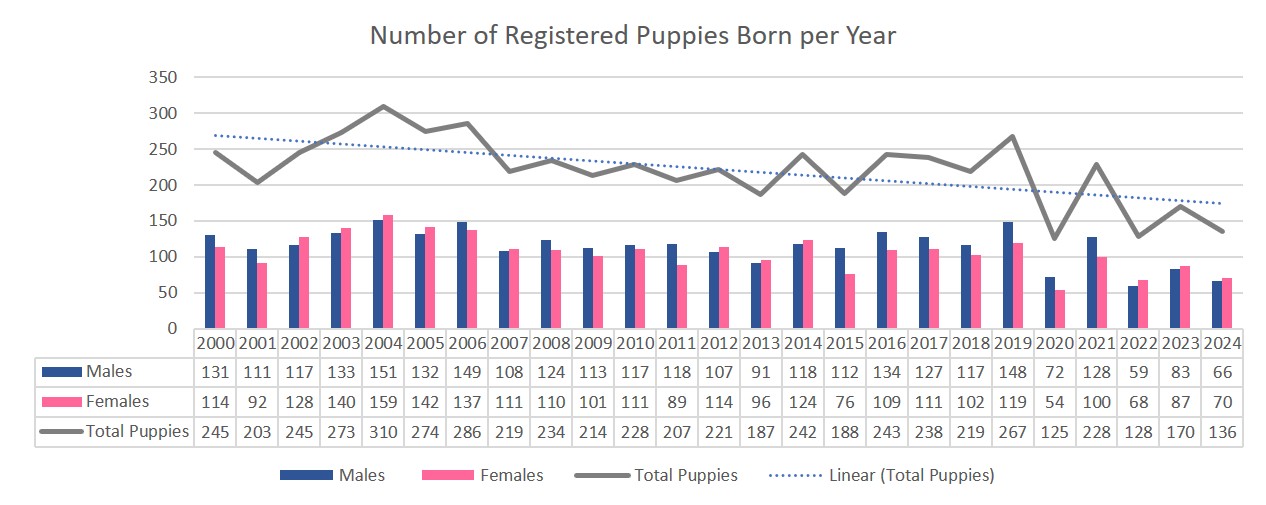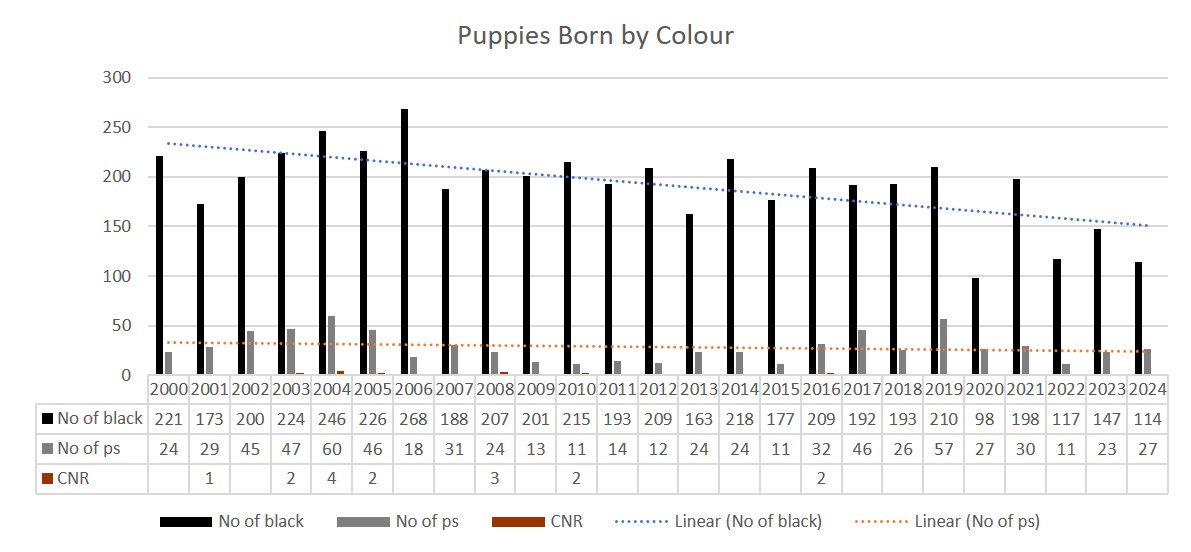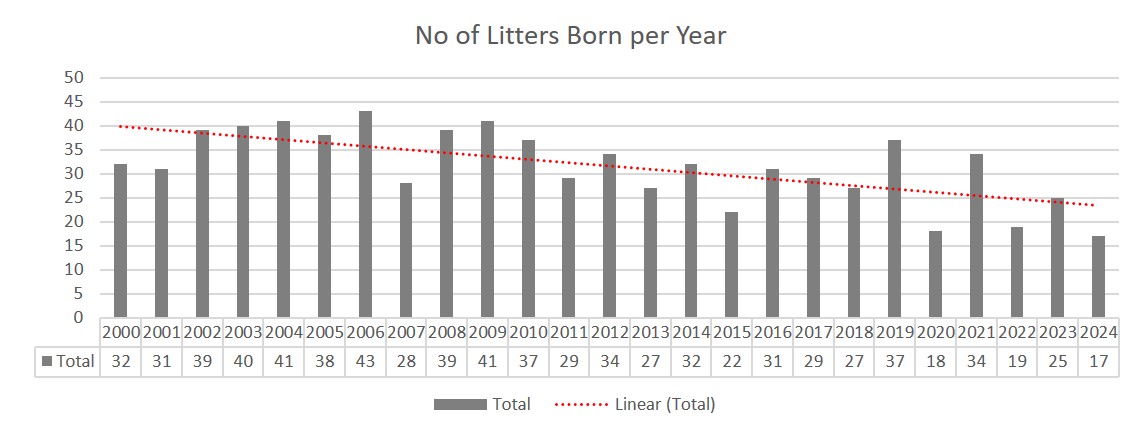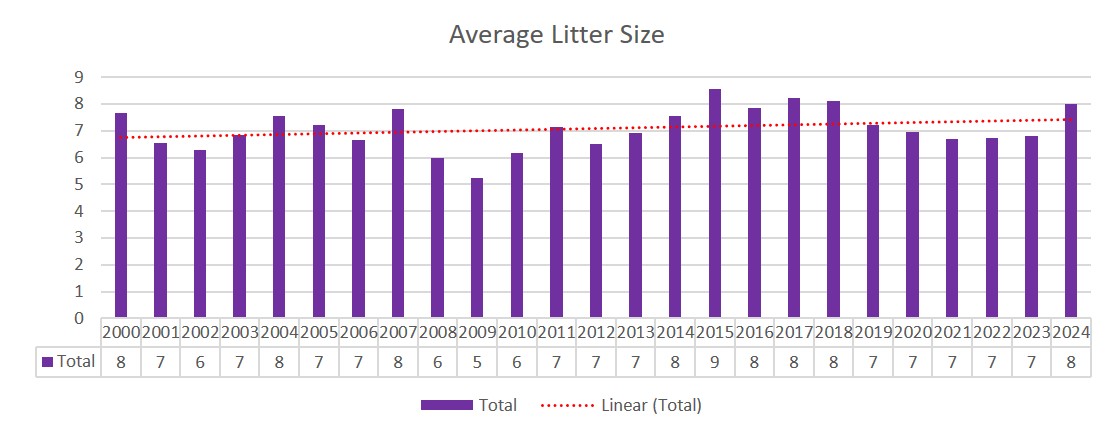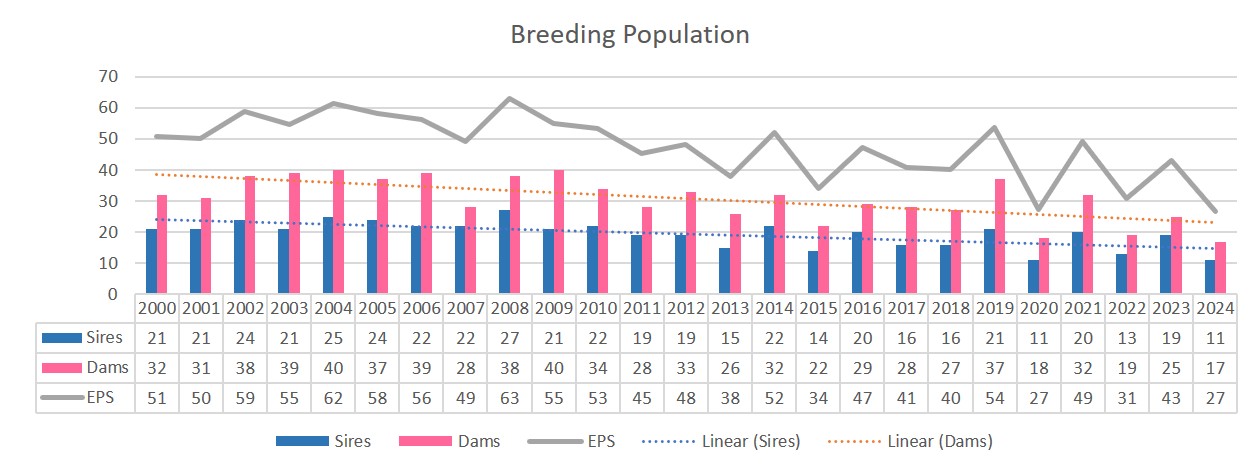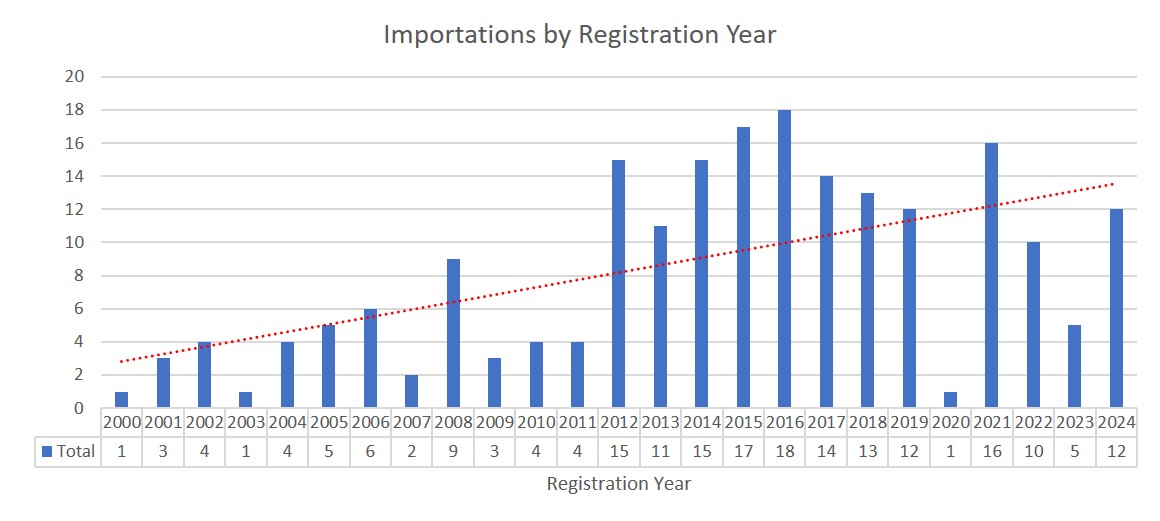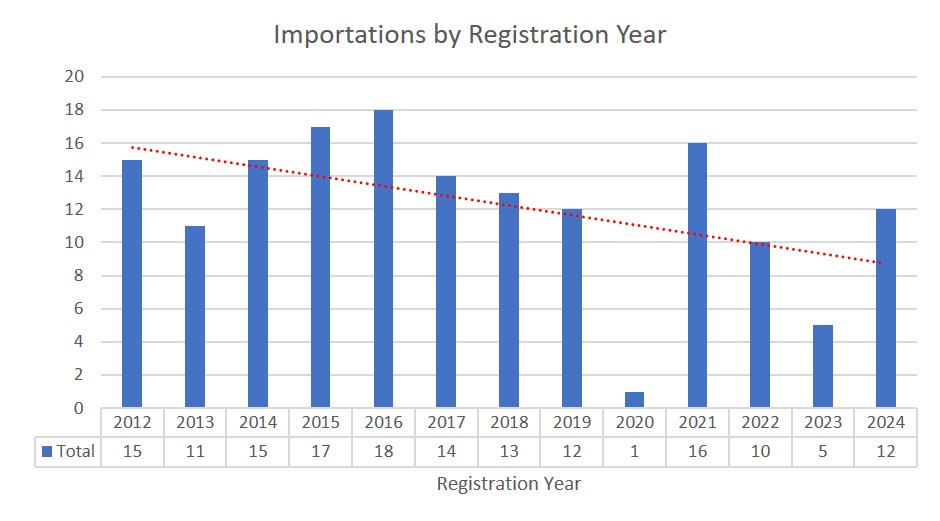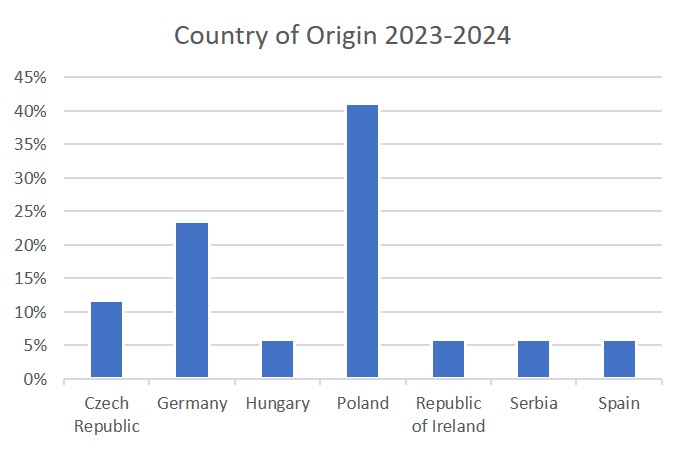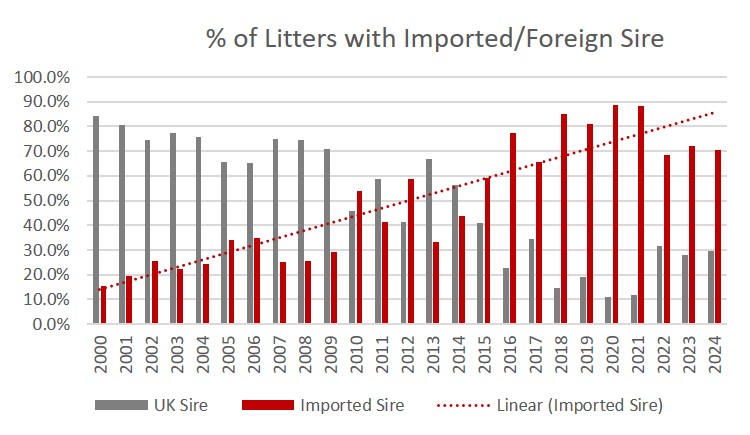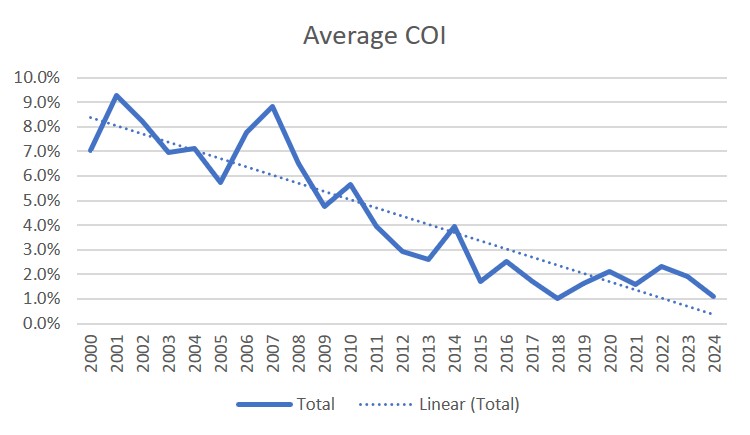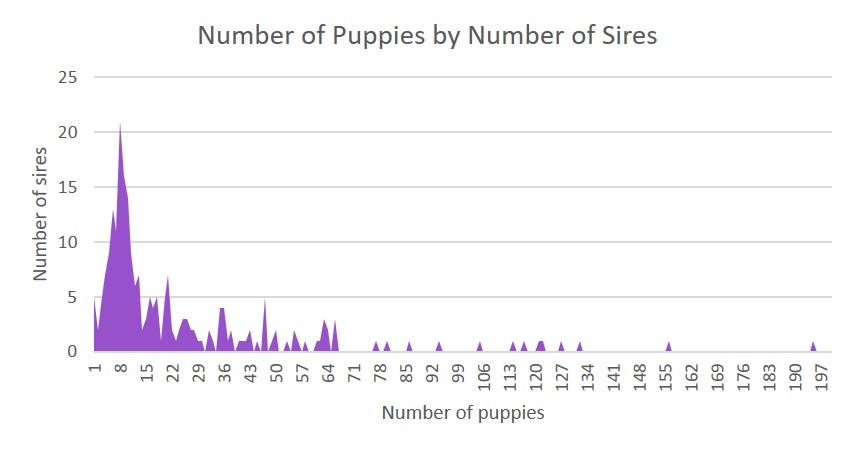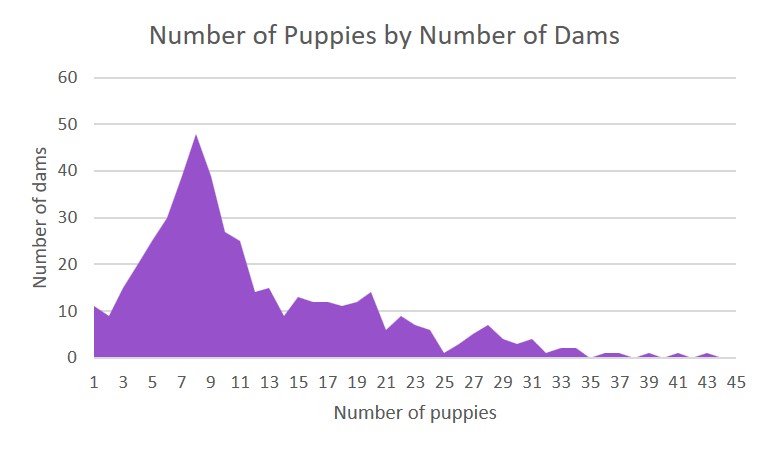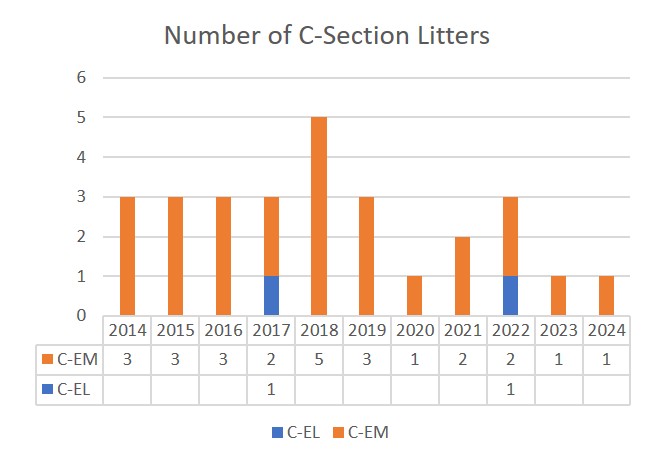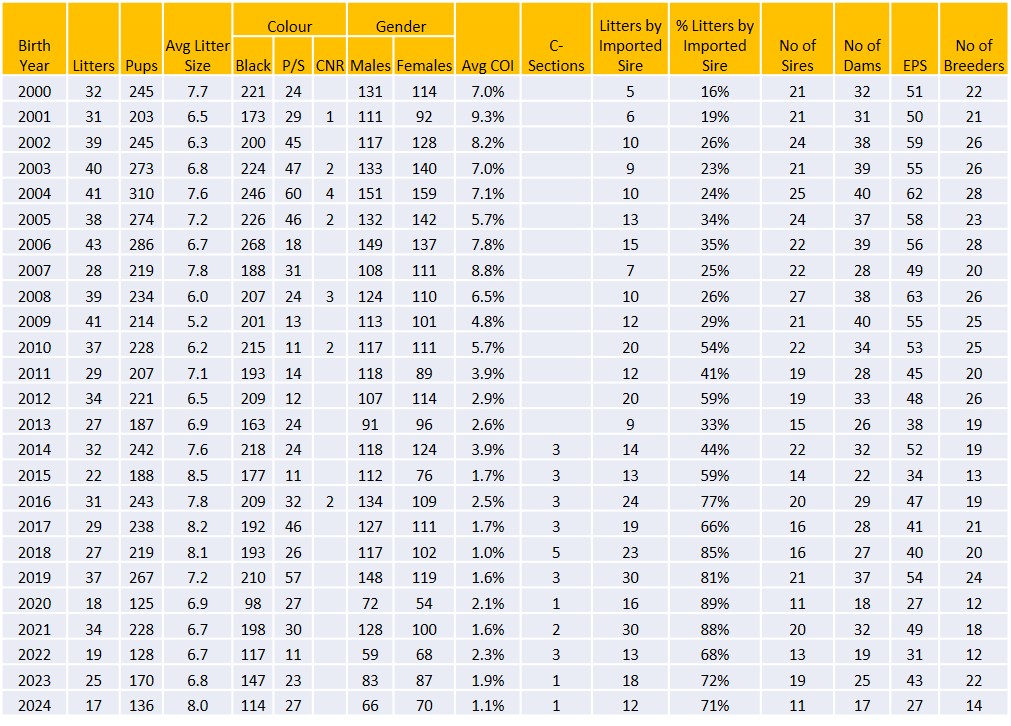Giant Schnauzer Breed Analysis in the UK – (Year 2000 To 2024)
Updated 2025
Breed health surveillance is an essential part of health planning for the future of a breed and monitoring underlying trends is one of a number of different ways that potential health problems may be highlighted. In addition surveillance may also demonstrate improvements and uniformity in a breeds health status. Analysis of information such as the number of litters, puppies and average litter sizes can provide useful information, e.g. a decrease in litter size and number of litters could raise suspicions of conditions associated with infertility. Also monitoring the overall breeding population is key to determining a breeds sustainability into the future. Monitoring issues such as the average inbreeding coefficient can go towards determining and improving genetic diversity.
The Kennel Club (KC) recommend that breed clubs should undertake continuing breed health surveillance as part of an overall strategy to develop and maintain health improvements within a breed.
The following information provides an annual breakdown of some of the fundamentals associated with Giant Schnauzer puppies born and registered with the Kennel Club in the UK since the year 2000. All graphs and data are centred around information recorded in the UK Kennel Club Breed Record Supplement (KC BRS), and inbreeding coefficients are based on those provided by the Kennel Club health results database.
Puppies Born and Registered Per Year
Graph 1 below shows the number of male and female puppies born in the UK per year and registered with the UK Kennel Club. The graph includes a trend-line that demonstrates an overall gradual decrease since 2000. On average the number of registered puppies has gone down by 38% over the last 24 years. The number of puppy registrations went down drastically in 2020 (during the covid pandemic lock-down restrictions), then increased again the following year, but since continued to decline. The average number of puppies born per year over the last 5 years is just over 150 puppies per year.
A further breakdown in the number of puppies born is shown in graph 2 below which demonstrates the number of black Giant Schnauzer puppies compared to Pepper & Salt. Both colours show a gradual downward trend: Black down 39%, Pepper/Salt down 27%. Puppies recorded under ‘CNR’ prior to 2016 were actually registered as Black & Silver, and later as ‘Colour Not Recognised’ when the KC changed the way colours were registered. In October 2020 ‘Colour Not Recognised’ changed again to ‘Non-Breed Standard Colour’ (NBS). The frequency of registered Black/Silver puppies is very low, only 2 in the last 10 years.
The number of litters born, and registered, per year also shows a downward trend on average by 44%.
The trend in average number of puppies per litter since 2000 is shown in graph 4 below, although was a slight decrease associated with smaller litter sizes for a few years 2008-2019, the average litter size is generally between 7-8 puppies.
Breeding Population – Effective Population Size (EPS)
The Effective Population Size (EPS) is the number of individuals in a population that contribute offspring to the next generation, and can be calculated from the number of breeding males and females per year using the following formula:
Ne = (4 x Nm x Nf ) / (Nm + Nf )
where Nm is the number of males and Nf the number of females used for breeding per year.
The breeding population graph 5 shows a reduction in the effective breeding population size of the Giant Schnauzer over the past 24 years. A so-called ‘50/500’ rule states that to avoid inbreeding depression (i.e. loss of ‘fitness’ due to genetic problems), an effective population size (Ne ) of at least 50 individuals in a population is required. According to Bradshaw [2] 50 is too low to ensure no inbreeding depression for the majority of species that have been investigated. In fact, Ne ≥ 100 is closer to the real minimum. The Kennel Club [3] state that moving forward we need to look at ways to manage the genetic diversity in the dog population to try and prevent breeds from becoming genetically homogenous (i.e. two copies of the same gene). One way of achieving this is to ensure there is a greater number of individual dogs contributing to the genetic population, in addition to avoiding the use of popular sires and maintaining a low inbreeding coefficient.
The statistics show a decline in the number of individual breeding dogs, and since 2011 this mainly fell below the minimum level of 50 required to prevent the inbreeding depression already mentioned. In 2020 the number of registered dogs used for breeding fell during the covid pandemic and in 2024 this decline is repeated with only 11 males used for breeding.
Importations into the UK
In 2001 the pet passport scheme was introduced, making it easier to import dogs. However, at that time, the scheme required a 6 month wait period following rabies vaccination. This meant imports either had to remain with their breeder until 6 months following a rabies vaccination, or to enter the UK into quarantine for the 6 month wait period. On 1st January 2012 DEFRA implemented new changes, which meant dogs could be brought into the UK just 21 days following a rabies vaccination. Since this change in January 2012 the number of imports increased significantly. See Graph 6a.
During 2020, covid restrictions and the Kennel Club’s introduction of a new computer system delayed registration of imports unit the following year. Therefore 2020 showed only 1 import due to the registration delay. The Kennel Club banned applications to register dogs from Russia and Belarus from 5th March 2022, in support of Ukraine during the war with Russia.
In more recent years since the relaxation of the pet travel rules in 2012, following the initial sudden increase in imported dogs, the number of imports has now began to decline again slightly. Graph 6b
The countries of import from 2012-2022 (before the banning of Russian import registrations) are show below with Germany (18%) and Russia (16%) being the most popular countries of origin.
Following the banning of Russian import registrations in 2022 over the last 2 years, the country of origin has so far shifted to Poland.
Graph 7 below shows an increase in the use of imported or foreign sires, although the use of imported sires has increased significantly there has been no significant corresponding increase in the effective population size, and the EPS has continued to decrease on average, which may indicate that individual imported sires are used on a frequent basis and produce a greater number of litters (the so-called Popular Sire effect). Currently around 70% of litters are sired by an imported or foreign bred sire.
Graph 8 below shows the average inbreeding coefficient per year for puppies born and registered in the UK using the Kennel Club’s health test result finder, which demonstrates a significant downward trend. This may be related to the increased use of imported or foreign sires over the same period. It is worth noting that the Kennel Club’s current pedigree database and inbreeding coefficient calculator only uses 3 generations to calculate the COI of imported dogs, and therefore may underestimate the actual inbreeding coefficient. In January 2012 the UK Kennel Club also prevented the registration of offspring from any mating between father and daughter, mother and son or brother and sister. The current Kennel Club breeding guidelines state that, where possible, breeders should produce puppies with an inbreeding coefficient which is at, or below, the annual breed average and ideally as low as possible.
Number of Breeders
The number of breeders having litters each year is also following a gradual downward trend. The majority of breeders, who have registered their puppies, are on the whole regular breeders or exhibitors who have a small number of litters along with a few who work their Giants. Only a small number of unknown one time breeders produce litters that are registered with the KC. The number of breeders/litters that are not registered is not known.
Popular Sires
Graph 10 below shows evidence for popular sire effects, based on puppies born since the year 2000, the majority of sires produced less than 30 puppies, 34 sires produced between 30 and 60 puppies, with 13 sires producing between 60 and 90 puppies. The graph also demonstrates that 10 sires produced over 90 puppies, with 1 sire producing over 190 puppies, with 8 of the main producers being imported dogs.
According to Farrell et al [4] widespread use of a popular male to sire many litters leads to over representation of that dog’s genome in the breed. As a consequence, the genetic diversity within a population is reduced, leading to a smaller effective population size.
Number of Puppies Per Dam
The number of puppies per dam is shown in the graph below. The majority of females produced 1-2 litters having less than 30 puppies in total each. 64 females produced 3 litters ranging from 11-34 puppies, and 21 females produced 4 litters ranging from 13-41 puppies per dam.
Litters Born By Caesarean
In 2014 the Kennel Club began recording and identifying litters born by caesarean section to facilitate monitoring and emergence of any health/welfare issues associated with whelping. Caesareans are recorded as either emergency (C-EM) or elective (C-EL). This followed the KC’s announcement in 2012 that no more than two litters born by caesarean section, in addition to no more than four litters in total, may be registered with the Kennel Club from the same bitch. Since then 1-5 litters (2-21%) per year were reported as requiring caesarean section. Of the litters born via caesarean during this period, the number of registered puppies from each c-section litter varied between 3-13 puppies. Without more research it is currently not possible to determine any particular health reasons requiring caesarean section, however there is potentially an association with large litter sizes.
Summary
- UK Giant Schnauzer annual puppy registrations have reduced on average by 38% over the last 24 years
- Average litter size has generally remained between 7-8 puppies
- Breed average Coefficient of Inbreeding has reduced from around 8% in 2000 to 1.1% in 2024 and this is likely related to an increase in the use of imported sires, and KC COI calculations based only on 3 generations
- Importations increased dramatically after relaxation of pet travel rules in 2012 and is now beginning to fall slightly
- The majority of imports were from Germany and Russia, however since the banning of Russian import registrations in 2022 imports from Poland have increased
- The breed’s Effective Population Size has decreased by around 42% over the last 24 years with an average decline in both the number of males and females used for breeding
- The number of breeders is gradually declining
- There is evidence of ‘popular sire effect’ which will impact on the breed’s overall genetic diversity
- The number of litters born via caesarean section is, on average, 10% and there may possibly be an association with large litter sizes, although more research is required.
Summary of data formulated from the KC BRS and KC Database
Lesley Parker May 2015 (Updated 2017, 2019, 2020, 2022, 2025)
Giant Schnauzer Breed Health Co-ordinator
References
- Kennel Club Breed Record Supplement, Working Group 2000 – 2022
- Bradshaw, CJA 2014. We’re sorry, but 50/500 is still too few. ConservationBytes [online]. Available at: http://conservationbytes.com/2014/01/28/were-sorry-but-50500-is-still-too-few/ [Accessed 8/5/015]
- Kennel Club. Genetic Diversity – Managing and Maintaining Diversity [online]. Available at: https://www.thekennelclub.org.uk/health-and-dog-care/health/getting-started-with-health-testing-and-screening/genetic-diversity-managing-and-maintaining/ [Accessed 26/9/2022]
- Farrell, Lynsday L. Schoenebeck, Jeffrey J. Wiener, Pamela. Clements, Dylan N & Summers , Kim M. The challenges of pedigree dog health: approaches to combating inherited disease. Canine Genetics and Epidemiology [online]. Available at: http://www.cgejournal.org/content/2/1/3 [Accessed 8/5/015]

